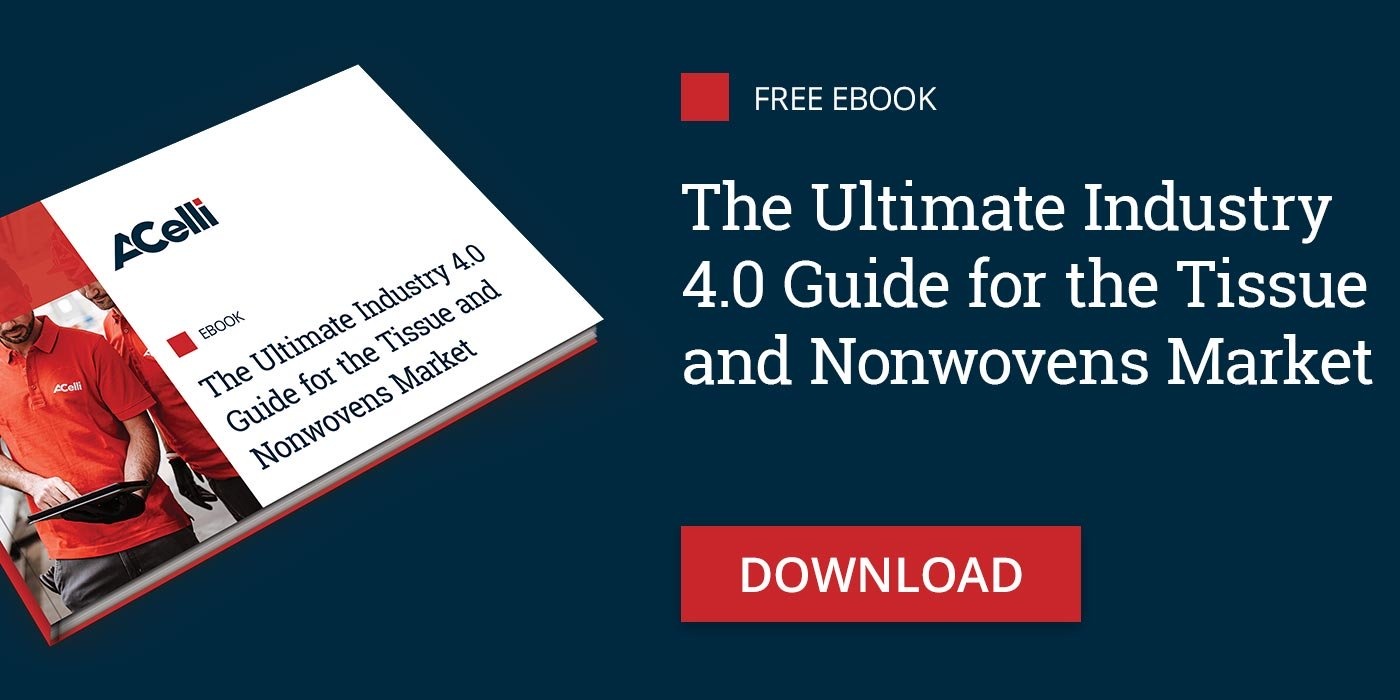Industry 4.0 is the new buzzword in the manufacturing sector. This is as true for the tissue and nonwovens industry as it is for any other manufacturing industry.
With technology changing at a rapid pace, the need for sustainability taking center stage and the ever-present goal of manufacturers to increase productivity, it is critically important for modern companies to have Industry 4.0 set up and running in the most efficient way possible.
In order to accomplish this, they must embrace a cloud-based Industry 4.0 solution that will allow for full integration between machines, devices, and corporate applications.
The key role of Cloud Computing in Industry 4.0
Industry 4.0 is all about taking the computerization and automation of machinery to the next level, to minimize the need for direct human control of the system and to increase process automation. Yet, machines, equipment, devices, and applications can only communicate with each other when they are all on the same network. While you could have an on-premise, wired network, this would limit the connected devices to those that are onsite. There would be no remote connection to machinery, and this is why the cloud is the foundation of Industry 4.0: it makes remote connectivity possible.
Remote connectivity means that tissue and nonwovens companies that operate plants in several locations, whether they are in the same city or spread around the world, can ensure all their machines in all their plants can communicate with each other and with corporate applications in real-time. It is over the cloud that data gathered from the thousands of sensors on positioned on the machinery are sent to be collected and analyzed. And these data are the backbone of every operation.
Read more: How to Measure Tissue and Nonwovens Mill Machinery Performance with Real Time Analytics
Why Cloud Computing and System Integration are important for Machine and Corporate Applications
The data from the production line are not the only ones that matter in a tissue and nonwovens company. Each company operates within the boundaries of overall corporate goals, and these include: turning a profit, planning for the future of the business, ensuring customer satisfaction and engagement, and increasingly, operating sustainably. These are strategic operational decisions that are made at the C-level and they are the basis of every policy and procedure that is implemented within the company.
Read more: How to Set Up Data Driven Production Processes in Tissue & Nonwovens Industries
These corporate level operational data are processed by corporate applications such as:
- business intelligence;
- business continuity planning;
- automated billing systems;
- payment processing;
- HR management;
- enterprise resource management.
The question is how do all those data coming in from the plant machinery, in all the plants operated by a company, get integrated with all the data and information held within corporate applications? The answer is by using a comprehensive platform that will bring each data stream to a single dashboard, where it can be analyzed on its own or in relation to all other data.
Full Integration gives you the Full Power of the Data
Where the cloud is the foundation of Industry 4.0, it is full integration that makes this technology truly powerful. In the early days of cloud computing and smart software, each machine, device and piece of equipment would have its own software that would send data via the cloud. The problem was that once these data were received from each disparate system, they were then just a mess of information. The data from one system or machine was difficult to analyze in relation to any other system or machine, and that meant there was a lot of untapped potential.
Unfortunately, this is how most tissue and nonwovens companies still operate today. To rectify this situation, A.Celli created their digital solution. This is a software-and-machine independent platform that ties all these disparate systems and machines together, which means that all the data from each and every machine in each and every plant will flow into the same platform, along with all the data from corporate applications. This is where machine learning and artificial intelligence will be able to organize the data, analyze them in relation to all the other data, see patterns within them and come to meaningful conclusions for the business management, such as:
- where anomalous data occurs and whether it is cause for concern;
- schedule predictive maintenance to reduce machine downtime;
- reduction of waste and energy usage;
- improvement of product quality;
- asset management;
- supply chain management.
Machine Learning is the Final Piece of the Puzzle
So, the machine sensors collect data. Cloud computing makes it possible to send those data over the network, so they all end up on a single API that connects them with all the other machine and corporate data.
The final piece of the integration puzzle is machine learning, which analyzes data and, through the use of algorithms, uses those analyses to make adjustments to plant operations and processes, ensuring they are in line with high level corporate goals. These adjustments can happen at the level of a single machine part all the way up to the level of corporate policies and procedures. Plus, machine learning is designed to automate the entire process.
Final Word
When it comes to Industry 4.0, the cloud and the integration of machine and corporate applications go hand-in-hand. It is through a thorough integration of all data from across the company, both vertically and horizontally, that true insight into operations can be gained and company operations can be optimized for the benefit of all stakeholders, including the company, shareholders, suppliers, and customers.
For more information about data and production processes in your tissue and nonwovens mill, please take a look at our eBook The Ultimate Industry 4.0 Guide for the Tissue and Nonwovens Market.

